Reverse Total Shoulder Replacement: Helps Patients Regain Shoulder Function Sooner
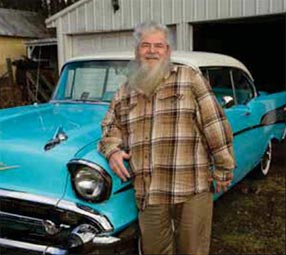
Following reverse total shoulder surgery in January, Ray Shifflett can now perform his regular daily activities free of pain, including taking care of his prize 1957 Chevrolet.
Ray Shifflett’s shoulder had been hurting for 15 years. For a long time, he kept the pain at bay with physical therapy and anti-inflammatory medicines like ibupro-fen and acetaminophen. But in the past year, the pain became unbearable.
"I couldn't sleep, I was in so much pain," says Shift-flett, 73, of Elkton. "I couldn't get any relief."
When simple activities like tilling the soil in his garden, washing his car and doing tasks around the house became too difficult, Shifflett went to see his primary care physician at Sentara East Rockingham Health Center.
An X-ray showed severe arthritis with as-sociated changes in the shoulder that indicated a severe rotator cuff tear. Shifflett, now retired, blames the damage to his shoulder on the heavy lifting he did for 10 years as part of his job. He was referred to Chad Muxlow, DO, at Sentara RMH Orthopedics and Sports Medi-cine, who determined that Shifflett was a perfect candidate for reverse total shoulder replacement surgery.
"I'd never heard of it before," says Shifflett.
Not Your Typical Shoulder Replacement Surgery
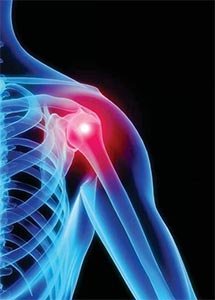
Dr. Muxlow joined the staff of Sentara RMH in August 2013, bringing unique skills as an orthopedic and sports medicine surgeon, including the ability to perform reverse total shoulder replacement. "It's not a common procedure," He says. "It's for a shoulder with arthritis, in addition to a severe rotator cuff tear, that gets so bad, nothing else can be done.”
Each year, thousands of people with shoulder arthritis undergo conventional total shoulder replacements, according to the American Academy of Orthopedic Surgeons. However, this type of surgery does not help patients, like Shifflett, with large rotator cuff tears who have developed a complex type of shoulder arthritis called “cuff tear arthropathy.” For these patients, reverse total shoulder replacement may be the only viable alternative.
"It's a procedure for when there are no other options for the patient,” Dr. Muxlow says. Candidates for the surgery are typically in their late 60s and older. A conventional shoulder replace ment device mimics the normal anatomy of the shoulder: a plastic “cup” is fitted into the shoulder socket, and a metal “ball” is attached to the top of the upper arm bone, the humerus.
"it creates a mechanical advantage by allowing the other muscles of the shoulder to elevate the arm without the rotator cuff,” Dr. Muxlow explains.
In a healthy shoulder, he notes, the rotator cuff muscles help position and power the arm during range of motion. A conventional replacement device also uses the rotator cuff muscles to function properly. But in a patient with a large rotator cuff tear and cuff tear arthropathy, these muscles no longer function. The reverse total shoulder replacement relies instead on the deltoid muscle to power and position the arm.
“The surgery is technically demanding,” says Dr. Muxlow. “Getting the stability and function is difficult to achieve because you’re changing the mechanics of how the shoulder functions.”
The reverse total shoulder replacement has been done in europe since the 1980s; the U.S. Food and Drug Administration approved its use in the United states in2003. It carries the same risks as any surgery, including blood loss and infection. Complications specific to a total joint replacement include wear, loosening or dislocation of the components.
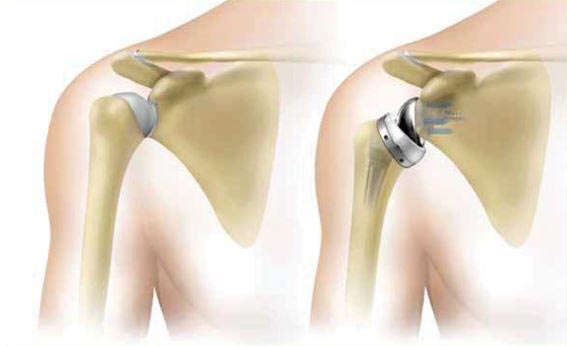
The reverse total shoulder replacement is so named because the surgical procedure reverses the natural anatomy of the glenohumeral joint in the shoulder. The glenohumeral joint (left) is a ball-and- socket joint, with the “ball” of the upper arm bone (humerus) fitting into the cuplike socket of the scapula (glenoid fossa). Following reverse total shoulder replacement (right), the positions of the ball and socket are reversed. (Images courtesy of Biomet Orthopedics)
Quicker Return to Shoulder Function
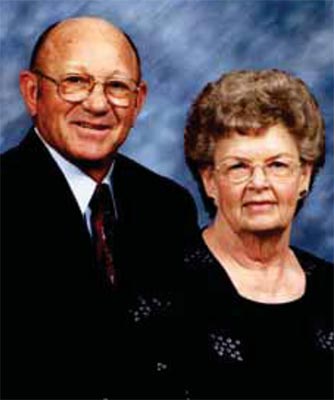
Mary Russell is so pleased with the outcome of her reverse total shoulder replacement surgery, performed by Dr. Chad Muxlow in December, that she hopes to have the same procedure performed on her right shoulder. Her husband, Willie, was her primary caregiver during recovery, she says.
Shifflett was impressed with his surgery experience, which took place in january 2014. It took about two hours. After the procedure, he spent one night in the hospital. He returned home with his arm in a sling and had physical therapy three times a week for several weeks to work on his range of motion. His physical therapy ended in March.
With reverse total shoulder replacement, the shoulder function returns much sooner than with conventional shoulder surgery, says Dr. Muxlow.
“With rotator cuff surgery, the tendon must heal to the bone,” he says. “But with the reverse shoulder replacement surgery, there’s no tendon repair to actually heal, just the surgical scar and tissues.”
Mary Russell of Elkton says the only pain she felt after her reverse total shoulder replacement was soreness from the surgery. Russell, 74, has suffered with arthritis for many years. She had two successful hip replacements in 2012. At the time, her orthopedic surgeon recommended the reverse shoulder surgery, but she did not want to travel to Charlottesville for the procedure.
Russell continued to lose the use of her left shoulder, even giving up her hobby of basket weaving. Then, in the summer of 2013, while stringing beans from her family garden, she experienced extreme pain when reaching for beans from the basket.
"I knew it was time," she says.
By that time, Dr. Muxlow had joined the staff of Sentara Orthopedics and Sports Medicine, so she was able to schedule the surgery at Sentara RMH.
"I was thrilled I wasn't going to have to go across the mountain or that my family wouldn’t have to go across the mountain to visit or bring me back and forth,” Russell says.
She had the surgery in December 2013. She was surprised at how well it went.
"I'm real plased," Russell says. "We're blessed to have Dr. Muxlow at Sentara RMH. He’s a very good surgeon.”
She hopes to have the same procedure done on her other shoulder.
Recovery from the reverse shoulder surgery takes about six to eight weeks, until the shoulder becomes stable, Dr.Muxlow says. In the meantime, no lifting, he adds.
Ambition to be an Orthopedic and Sports Medicine Surgeon
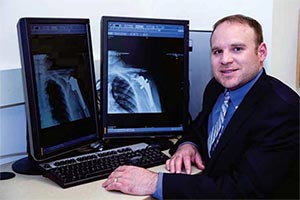
"Recovery from the reverse shoulder surgery takes about six to eight weeks."
— Dr. Chad Muxlow
Dr. Muxlow knew as a teenager that he wanted to be an orthopedic surgeon. As a high school athlete, he injured his knee and needed surgery. A friend’s father, an orthopedic surgeon, performed the procedure. Dr. Muxlow was impressed.
"I always liked sports and the mechanical nature of the body,” he says. “So orthopedic sports medicine was a perfect fit for what I like to do."
After graduating from Michigan State University (MSU) College of Osteopathic Medicine, Dr. Muxlow completed his orthopedic surgery residency at McLaren Orthopedic Hospital and Sparrow Hospital through MSU. He completed his fellowship in arthroscopy and sports medicine at Orthopedic Research of Viginia in Richmond.
Learning the reverse shoulder surgery “was just part of my training," Dr. Muxlow says. "It's something I can offer to the community that no one else does."
Shifflett is glad Muxlow brought his talents to Sentara RMH. He says he’s had no pain in his shoulder since the surgery.
"It's remarkable," he says. Now he's able to dress himself, tie his shoes and slip on his coat with no pain.
"I recommend this to anyone with shoulder pain,” Shifflett says. “Go see Dr. Muxlow.”
Dr. Chad Muxlow, of Sentara RMH Orthopedics and Sports Medicine, is currently the only orthopedic surgeon in the area who performs reverse total shoulder replacement. The surgery, he says, is for a shoulder with arthritis and a severe rotator cuff tear that gets so bad nothing else can be done for it. The X-ray images show the placement of the prosthetic devices after surgery.
